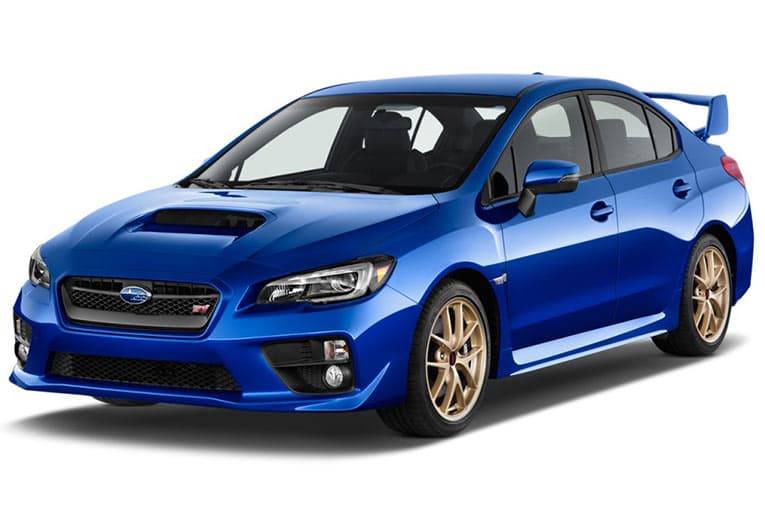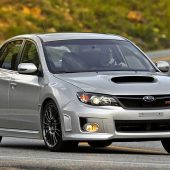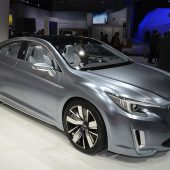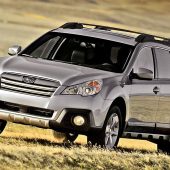Subaru of America introduced the 2015 Subaru WRX at the Los Angeles Auto Show. Powered by a new 268-horsepower 2.0-liter direct-injection turbo BOXER engine, the 2015 Subaru WRX debuts the model’s first six-speed manual transmission and a new, optional performance automatic transmission, the Sport Lineartronic CVT with two manual modes. For 2015, the Subaru WRX employs a new torque-vectoring system that supplements the standard Symmetrical All-Wheel Drive system. Torque vectoring allows for improved cornering speeds and handling. The new and stiffer chassis, larger brakes, performance-tuned suspension and a driver-focused interior remain integral to the WRX performance character. The new powertrain also yields higher fuel efficiency than the previous model.
The new Subaru WRX features a much bolder front design with a deep front spoiler and unique grille. The wide-body stance seen on the previous model is enhanced with new, standard 17-inch wheels. The hood, front fenders, rear doors and quarters, bumpers, headlights and taillight clusters are all unique to the 2015 WRX. Specially designed for the 2015 WRX, the rear doors and fenders continue the model’s wide-body stance in a rakish new profile. The Subaru hexagonal grille is flanked by narrower headlights designed to evoke a raptor’s stare. The functional hood scoop, which supplies the intercooler with fresh air, is now set more deeply into the hood to provide better forward visibility.

Other new performance-oriented details include foglight surrounds with a carbon fiber-like pattern and vertical front fender vents that feature a bright garnish and a mesh screen. Higher-grade models use new LED low-beam headlights; halogen lights are used on other models. The side sill spoilers that help to visually lower the car also help protect the doors from rock chips. New standard 17-inch wheels feature a more aerodynamic design. At the rear, LED taillights, a diffuser, LED center high-mount stoplight (CHMS) and an available lip spoiler leave a distinctive signature.
The new WRX body structure makes greater use of high-tensile strength steel than the previous model and features special stiffening elements at key locations. Combined with the new Electronic Power Steering system, specially tuned suspension and 235/45 R17 94W Dunlop SP Sport Maxx RT tires, the stiffer chassis yields steering response that was benchmarked against top-handling sports cars.
The new WRX 2.0-liter, 4-cylinder BOXER engine uses a combination of direct fuel injection, high compression (10.6:1), Subaru Dual Active Valve Control System (D-AVCS), a twin-scroll turbocharger and an intercooler to achieve outstanding performance and high efficiency. The engine produces 268 horsepower at 5,600 rpm, accompanied by a broad torque curve that peaks at 258 lb.-ft. over a 2,000-5,200 rpm engine speed range.

The new 6-speed manual transmission provides a wider ratio spread than the previous 5-speed and incorporates several performance and durability improvements for this high-performance application, including carbon synchronizers on first and second gears. The 2015 WRX introduces the option of a new automatic transmission. The new Sport Lineartronic CVT combines the benefits of a continuously variable transmission (high fuel efficiency, ultra-smooth driving character) with the choice of stepped automatic shifting eight pre-selected ratios (when in Sport Sharp mode) and also 6-speed and 8-speed manual shifting modes using steering wheel paddle switches.
When equipped with the 6-speed manual transmission, the 2015 Subaru WRX uses the brand’s Continuous AWD version of Symmetrical All-Wheel Drive. A viscous coupling locking center differential nominally distributes torque 50:50 front to rear, and Vehicle Dynamics Control (VDC) provides stability and traction control. Should slippage occur, this system transfers more power to the wheels with the best traction.
The new Sport Lineartronic CVT is teamed exclusively with the Variable Torque Distribution (VTD) version of Symmetrical All-Wheel Drive. A planetary gear-type center differential and an electronically controlled hydraulic transfer clutch control torque distribution between the front and rear wheels. Under most conditions, VTD splits the torque 45:55, with the rearward torque bias contributing to handling agility. The VTD system continually optimizes torque distribution in response to driving conditions and input from steering wheel angle, yaw and lateral g-force sensors.










